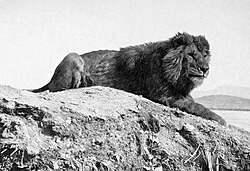Panthera leo leo
| Barbary lion | |
|---|---|

| |
| A Barbary lion from Algeria, 1893 | |
| Scientific classification | |
| Kingdom: | |
| Class: | |
| Order: | |
| Family: | |
| Genus: | |
| Species: | |
| Trinomial name | |
| Panthera leo leo (Linnaeus, 1758)
| |
The Barbary lion (Panthera leo leo) was a local group of lions which are now extinct in the wild {IUCN}. The Barbary lion was also called the Atlas lion and the Nubian lion. It was a local group, or perhaps subspecies, of the lion. It used to live in North Africa, from Morocco to Egypt.
Looks and behavior[edit | edit source]
The Barbary lion was large and heavy. Males weighed about [convert: invalid number], and females weighed about [convert: invalid number]. Male lions were said to be about 2.7 to 3.1 metres (8 ft 10 in to 10 ft 2 in) long and females were about 2.1 to 2.7 metres (6 ft 11 in to 8 ft 10 in) long.[1] Some scientists think that these sizes and weights are too large. These scientists think that the Barbary lion is probably the size of the lions found in East Africa.[2]
The places where the Barbary lion lived did not have a lot of prey. These lions did not live in prides because of this.[3][4] The main animals they hunted in the Atlas Mountains were the Barbary stag and the gazelle. The lions also ate cows and sheep raised by people.[5]
These lions lived alone, or in pairs. The female Barbary lion raised her cubs until they were mature. This took about two years. After that, the cubs left their mother.[5]
Sources[edit | edit source]
- ↑ "Barbary Lion". tigerhomes.org. 1999–2006. Archived from the original on August 24, 2011. Retrieved February 18, 2012.
- ↑ Patterson, Bruce D. (2004). The lions of Tsavo: exploring the legacy of Africa's notorious man-eaters. McGraw-Hill Professional. p. 110. ISBN 978-0-07-136333-4.
- ↑ "barbarylion.com". barbarylion.com. 2005. Retrieved February 18, 2012.
- ↑ A pride of lions is a family group. It usually includes a male lion, several female lions, and their cubs.
- ↑ 5.0 5.1 http://www.barbarylion.com/Barbary_Lions.htm/
- IUCN Red List extinct in the wild species
- Articles with 'species' microformats
- Taxoboxes with the error color
- Panthera
- Mammals of Africa
- National symbols of Albania
- State symbols of the Kingdom of Belgium
- Constituent symbols of England (UK)
- State symbols of the Independent Grand Duchy of Luxembourg
- State symbols of the Kingdom of The Netherlands
- National symbols of the Kingdom of Morocco
- National symbols of Libya
- Former National symbols of the Macedonian Empire (808 BC – 168 BC)
